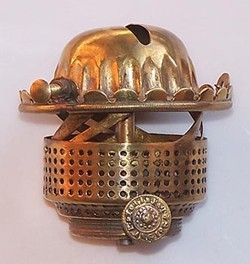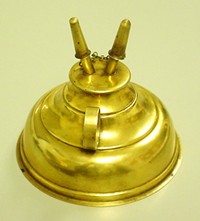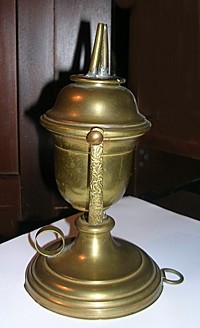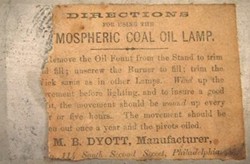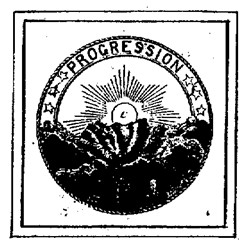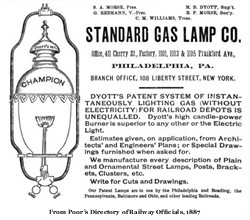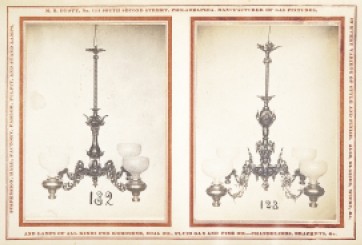Michael Boyd Dyott was born in England in 1823 and would go on to have a successful lamp business in Philadelphia, Pennsylvania.1 Dyott had some healthy competition in the Philadelphia area including Cornelius, Baker & Company; C.A. VanKirk; Archer, Warner, Miskey & Company; and other smaller lamp and lighting manufacturers.
Michael B., the son, would marry Mary Jane Grimes (b. Oct, 1822), a native of Maryland, on October 3, 1848 in Baltimore, Maryland. They would have one son, Charles G., born in December of 1849, who would at one time work as a printer (per the 1870 Census), then enter the trade with his father soon thereafter; and one daughter, Marion B., who was born in November of 1863.3
It seemed odd that the Dyotts would wait fourteen years to have their second child; most families of the period appear to have had their children much closer together, with larger gaps ranging from three to five years, but seldom more than a decade. The question was answered to some degree in the 1900 census. In the column titled "Mother of how many children," Mary Jane listed four; in the column titled "Number of these children living," she listed two. This would have referred to Marion, then aged 36, single, and still living with her mother, and Charles. Apparently, the Dyotts lost two children for reasons or causes unknown. There is no mention or reference to other children in any of the other census reports. Dyott's first patent, number 1742, was obtained on August 25, 1840 for a camphene lamp. Remarkably, he would have been seventeen years of age at the time. In A History of American Manufacturers from 1608 to 1860, under a list of the most important inventions patented between 1840 and 1850 is "to Michael B. Dyott, Philadelphia, for an improvement in the Lamp for Burning Camphene."4 He would go on to obtain more than twenty-five patents over a lengthy career, most of them for lamps, burners and other lighting devices. Follow this link to a chronological listing of M.B. Dyott's patents. There is also a list at the end of this article. By 1845, M.B. Dyott was in business at No. 64 South Second Street in Philadelphia. In the 1845 city directory, Dyott's listing is "camphine [sic] lamps, 64 S 2d." It is also around this time he becomes associated in business with Wilson Kent, likely from the mid-1840's through the early 1850s, trading as M.B. Dyott & Kent. On the advertising note depicted below, they are wholesale and retail dealers and manufacturers of Dyott's Patent Pine Oil Lamps, Chandeliers, Fluid, Solar, Lard & Oil Lamps, Candelabras, &c, &c. Also Gold's Patent Union Refrigerators and Water Coolers. 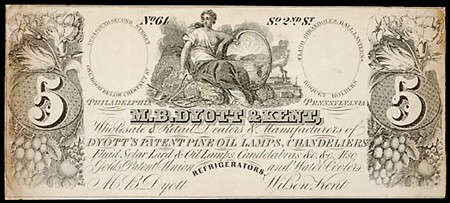 The reference to Gold's Patent Refrigerator relates to Job S. Gold's patent number 1998 granted on March 12, 1841 for his "Union Refrigerator." The refrigerator, or ice box, was to have a separate "apartment" for the ice and chilled water above the storage compartment. Interestingly, M.B. Dyott is noted as a witness to the patent. Job Swift Gold was the youngest of fourteen siblings and the brother of Stephen Johnson Gold of Cornwall, Connecticut. They were jointly involved in inventing a number of improvements in coal stoves and steam heating devices. Stephen also had two patents for lighting devices: number 2168 obtained on July 16, 1841 for a lamp for burning camphene, and number 3073 granted on May 8, 1843, for burning "pine oil." These S.J. Gold patents are similar to what Dyott was working on at the time. Job S. Gold died on June 21, 1844, at the age of 33. According to an article by R. Curt Chinnici in the Magazine Antiques, "When the Philadelphia lampmaker Job S. Gold died in 1844 the inventory of his shop listed many kinds of shades, globes, finished and unfinished lamps, marble bases, pine oil, wicks, French shades, paper shades, imported lamps, brass parts for lamps and store fixtures, and many tools used to turn brass sheets into lamps. In the inventory accompanying his will Gold held "patents rights" assessed at $150." Further research into the Gold brothers and their connections to Dyott is warranted.
The entry for the 1850 United States Federal Census lists his occupation as "Lamp maker." Interestingly, Dyott and his wife were enumerated twice in the 1850 census. When the census was taken on August 21st in Pine Ward, Philadelphia, Pennsylvania they were first counted. Less than two months later they had occasion to be in Maryland, visiting the residence of Charles Grimes, Mary Jane's father, when they were counted again on October 5th in Ward 11 - Baltimore City! By the end of October, 1854, Dyott & Kent outgrew their current store and relocated five doors up the street to No. 74 South Second Street.5 By 1860 M.B. Dyott had apparently ended his association with Wilson Kent and had again moved up the street to 114 South Second Street. In the April 2, 1860 edition of The Compiler, a Gettysburg, Pennsylvania newspaper, there is an article about Dyott's establishment that mentions chandeliers and other fixtures he has produced for various customers. One passage reads, "Mr. Dyott also has ready for being sent off to its destination a massive chandelier, bronze relieved with gold, got up for the Presbyterian Church, in Paducah, Kentucky, eight feet high, six feet in diameter; the ornaments commencing in floral beauty, and terminating in sun rays, and the whole weighing 300 pounds." For additional information, here is a transcript of the entire article. Upon further research, it was discovered that the First Presbyterian Church, originally built in 1848, was destroyed by fire on the night of January 29, 1932. One could assume that if the chandelier was indeed delivered to the church, that it was either removed prior to the 1932 fire, or was damaged or destroyed during the fire. The fact remains that the chandelier does not reside in the current church building. In January, 1863 Dyott patented the lamp burner depicted at the top of the page. In their circa 1884 catalog, The Bristol Brass and Clock Company advertises the New Dyott Burner. It is by all appearances the same burner, but upon closer inspection, one will note that the spiral gallery twists to the left on the "new" version and to the right on all of the examples that the author has seen. One would assume that it was a successful item having been manufactured for some twenty years. Later in 1863, Dyott invented a glass lamp with a depressed shoulder to function as a drip-catcher. For this he obtained patent number 40,094 on September 29, 1863. This appears to be one of the earlier inventions for this type of improvement. This patent was reissued on January 9, 1877, REISSUE number 7,458 and was assigned to George Henry Lomax. Many lamp collectors will recognize the Lomax name and associate it with the line of "Lomax Oil Guard" lamps.
Dyott was granted two patents for mechanical lamps - those which employed a clockwork driven fan to provide a consistent draft without the use of a chimney. One example employs Dyott's patent number 64,508 granted on May 7, 1867 for a glass fount designed to prevent the possibility of leaking fuel onto the clockworks. His other patent granted a year earlier on May 26, 1866 (pat. no. 55,075) is for a conical shaped fount designed to direct air more evenly and also functions as a drip catcher for oil and wick trimmings. Below is an image of the bottom of a Dyott mechanical lamp which still retains the majority of its original label. It states: "Directions for using the Atmospheric Coal Oil Lamp. Remove the oil fount from the stand to trim and fill; unscrew the burner to fill; trim the wick same as in other lamps. Wind up the movement before lighting and to insure a good light, the movement should be wound up every four or five hours. The movement should be taken out once a year and the pivots oiled. M.B. Dyott, Manufacturer, No. 114 South Second Street, Philadelphia."
By 1870, as noted in that year's Philadelphia City Directory, Charles G. Dyott was working as a clerk in his father's shop. Michael Dyott collaborated on three patents with Charles between 1879 and 1886: patent numbers 213,879, 326,550 and 334,698. Charles also obtained three lighting patents in his own name: 194,420, 374,144 and 427,979, and one for the propulsion of vehicles in 1904. At the Franklin Institute Exhibition in 1874, M.B. Dyott & Son won a Silver Medal in the category of gas fixtures for their Champion Street Lamps.6 In a short article in the November 7, 1874 edition of the South-Jersey Republican, Hammonton, New Jersey, the writer stated "This exhibition has proven a great success....It would require more room than we have to give, to speak fully of the numerous wonderful and beautiful things there to be seen....Among the most noteworthy, we mention the admirable display made by M.B. Dyott whose store is at 124 South 2d. st. Philadelphia, with his beautiful lamps..." The 1880 census entries for both Michael and Charles list their occupations as "Manuf. of Gas Fixtures." In addition to his lighting patents, Michael also obtained two patents early in his career for hot air furnaces (nos. 9,966 and 12,901) and one for the application of metal veneer or facings7 for buildings which employs a series of hooks upon which the metal panels hang and then the voids are filled with concrete, patent number 9,937, dated August 16, 1853. Aside from these "distractions," his innovations seemed to be almost singularly focused on the field of lighting.
In addition to his business dealings, M.B. Dyott and his wife were actively involved with the Spiritualist movement in the mid- to late-1860's. Records indicate that he attended their National Conventions from at least 1865 through 1869. He served on numerous committees, was a passionate and vocal advocate for a number of resolutions, particularly the Children's Lyceum, and held the offices vice president and treasurer at different times. At the Fourth Annual National Convention of Spiritualists, held in Cleveland, Ohio, September 3-6, 1867, "The Committee on Badges made a report, setting forth the propriety of inaugurating a society, to be designated the "United Order of Eternal Progress," and this committee was appointed to decide upon a badge to be worn by all members, designating them as the elect. The emblem is intended to be worn as a breast-pin, stud, or locket, by "Spiritualists," members of the "Children’s Progressive Lyceum,"
At the Fifth National Convention of Spiritualists, held in Rochester, New York, August 25-28, 1868, "A motion was made to pay M. B. Dyott $1100 for the patent of the medals. Six ayes, several hundred noes. [The funds of the society being low, the last vote was received with cheers.]" Further, "M. B. Dyott of Philadelphia submitted a report in regard to a Secret Order of Spiritualists. The report took the ground that it was improper to form a religious secret order, but that a benevolent order, embracing Spiritualists of both sexes, after the plan of the Odd Fellows’ Society, was highly proper and should be encouraged. The report was accepted and the committee discharged."9
At some point in time, yet to be determined, Michael B. Dyott must have dissolved or sold his company then went to work for The Standard Gas Lamp Company. The Standard Gas Lamp Company was a tenant of Morse, Williams & Co. at the Morse Elevator Works factory located at the corner of Frankford Road and Wildey Street through to Shackamaxon Street, 18th Ward, Philadelphia, Penna. The lamp factory occupied the fourth floor of building #2. They also occupied part of the second floor of building #7 where patterns and glass shades were stored. The company president was Stephen A. Morse of the celebrated Morse Elevator Works. In 1886 The Standard Gas Lamp Company employed four men. A.J. Reach & Co., a manufacturer of baseballs, was also a tenant of Morse. They employed 70 hands: 40 men, 20 boys, and 10 girls.10 The image above is taken from the 1887 edition of Poor's Directory of Railway Officials and lists M.B. Dyott as the superintendent of The Standard Gas Lamp Co. The ad features Dyott's CHAMPION street lamp. He would have been about 64 years of age at the time and would only live a short while longer. They had an advertisement in the 1888-89 directory as well, but Dyott is not listed. By the time Gopsill's Philadelphia City Directory for 1889 was compiled, M.B. Dyott had entered into rest as his wife, Mary Jane, is listed as widowed. The exact date and cause of death is under investigation by this author.
 Patent Search Interface Patent Search InterfaceTo view any of the patents referenced in this article, enter the patent number in the field below and click Query USPTO Database. This will open in a new window and take you to the U.S. Patent & Trademark Office Database - directly to the patent in question. Learn more about the USPTO here.
|
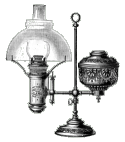
| Reference Desk | Lamp Information | Other Resources | On-Line Shopping |

Purveyors of Antique Lighting and Accessories
435 Main Street
 Hurleyville, New York 12747
Hurleyville, New York 12747
 Thumb wheel marked:
Thumb wheel marked:DYOTTS PAT JAN 6, 1864. The patent was actually granted in 1863, not 1864. --------------------- Enlarge image [+] |
 Thumb wheel marked:
Thumb wheel marked:DYOTTS PAT JAN 6, 1863. The "right" date, probably a later production burner. --------------------- Enlarge image [+] |
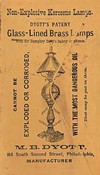 M.B. Dyott Illustrated Advertising Cover (reverse)
M.B. Dyott Illustrated Advertising Cover (reverse)--------------------- Enlarge image [+] |
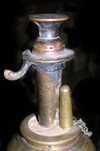 Dyott Vapor Burner
Dyott Vapor BurnerThe design conforms substantially to patent no. 16379, dated JANY 13, 1857 and DEC 7, 1858 Photo: Hugh Pribell --------------------- Enlarge image [+] |
 Early bracket lamp fount embossed
Early bracket lamp fount embossedM.B. DYOTT - PHILADELPHIA above the rib around the center. --------------------- |
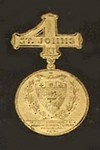 Dyott was a member of the St. John's Commandery Number 4, Knights Templar.
Dyott was a member of the St. John's Commandery Number 4, Knights Templar.He was knighted on October 27, 1871. --------------------- |
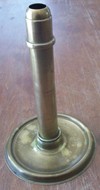 Early Dyott candle stick, spring loaded mechanism, marked: DYOTT PHILAD
Early Dyott candle stick, spring loaded mechanism, marked: DYOTT PHILADPhoto: V. Sabattis --------------------- Enlarge image [+] |
a biographical sketch of

Michael B. Dyott
^ Top of Page
Privacy Policy | Terms and Conditions of Use | Announcements
Copyright © 2001-2011 ~ Daniel Edminster | The Lampworks ~ All Rights Reserved
